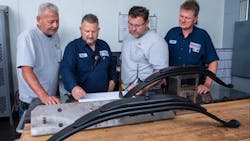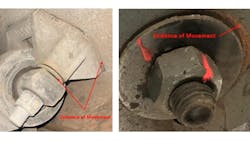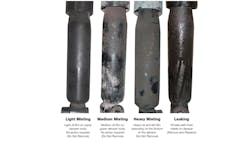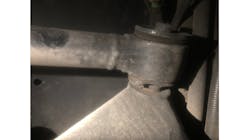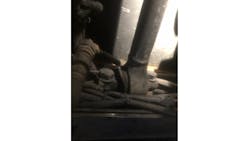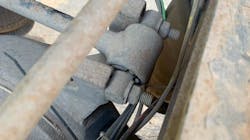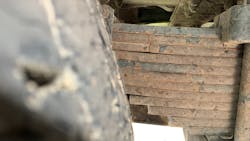In search of a smooth ride: Image examples of suspension wear and damage
Suspensions have the vital role of not only protecting the cab from bumps along the road but also cushioning the driver as well. Ensuring that heavy-duty trucks have a smooth ride makes for a happy driver, supporting employee retention and overall well-being.
But when components of air ride or leaf spring suspensions are worn or damaged, it can put drivers in an unsafe situation and cause poor ride quality, excess tire wear, and driver fatigue from inconsistent alignment due to suspension component wear or failure, according to Mike Adams, general manager at Blaine Brothers TruckAline.
Daily inspections can reduce downtime, and progressive damage can be avoided by identifying problems early. Components should be inspected by a reputable suspension repair shop if you believe there are signs of wear or failure, Adams emphasized.
Here are five common areas of focus in suspensions, including how to identify problem areas and how to fix them, helping to smooth out the inspection process and ultimately creating a more comfortable ride. (And at the end we provide a checklist for scheduling suspension maintenance.)
1. Under-torqued bolts
The most typical damage happens because of loose fasteners that were not torqued properly at the initial install, said Mark Molitor, sr. product manager of chassis suspensions at Link Mfg. “Maybe it’s only hit 75% of what it should have been torqued to,” he noted.
Before you can tell for sure if a fastener is under-torqued, a shakeout test should be performed. “You want to drive around for 500 to 1,000 miles to shake things loose,” Molitor explained. “Then the technician can go around and start looking for signs of movement.”
The most apparent sign that sliding has occurred is if the area around the washer or bracket appears different than the surrounding area, typically because the loose brackets scrape off dirt.
A visual inspection is the preferred method over listening for clanking, Molitor said, because the suspension systems on a work truck, like a dump truck or cement mixer, are too far from the driver to hear. Plus, the symphony of other rattling equipment doesn’t help. So stick with the eye test.
2. Shock absorber leaks
Shock absorbers should be inspected for damage to the shock body or the rubber mounting component, advised Melanie Elliott, marketing manager at Hendrickson. A leaking shock is not an out-of-service issue, but Elliot warned it can lead to reduced service life, increased tire wear, and ride quality issues.
A warm shock still provides some level of damping, so take the truck out on a short trip and then feel the shock, Link’s Molitor explained. Touch the frame rail to get a reference temperature, and if the shock is not warmer, it no longer provides the necessary damping, adding that a little bit of oil coming out is acceptable.
“That just means that it’s keeping the seals lubricated. So misting is good, but runs are bad,” Molitor said. “Shine is fine.”
3. Worn rubber bushings
Molitor said worn bushings are likely the hardest to identify, since many bushings are not in easily seen places. However, if the bushings can be seen, then a visual inspection of the edges can help to determine if they are getting close to the end of their life. He said to look for tears, bulging rubber, or a bent spacer. If seen on a lateral control rod, for example, it may no longer be fully controlling the lateral position of the axle.
“You’re going to start wearing out other suspension parts, and you’ll start having excessive tire wear—at $1,000 each,” Molitor said. “You don’t want a $200 control rod having a set of (four $1,000 tires) being worn out prematurely because of a faulty bushing.”
Worn or damaged bushings can cause axles to track erratically, increasing tire wear and possibly reducing fuel mileage, Blaine Brothers’ Adams said, adding that misaligned air springs may likely be an indication of worn bushings, alignment issues, or fatigued U-bolts.
4. Broken or damaged leaf springs
Broken or damaged leaf springs can cause reduced load capacity and misalignment, as well as becoming a road safety hazard if complete failure occurs, Adams said.
Rick Roy, project manager at EMCO, believes that under normal operating conditions, seeing general rust at the end of spring leaves is okay. But if it has a shiny, rubbing condition, something is loose and there’s another problem at play, such as a compromised spring or failing bushings. Another possibility is that the spring is at the end of its useful life.
Tony Beninsky, quality continuous improvement manager at EMCO, added that he looks for any rubbing on either side of the radius to the left or right, which is cause for concern, but a wear mark is evidence the leaf spring is doing its job on the roads.
5. Improper ride height
In terms of air suspensions, Hendrickson’s Elliot recommends that ride height should be inspected during the pre-delivery inspection phase and then quarterly thereafter. The driver should also visually verify that the ride height is correct during his daily vehicle pre-trip inspection. Damage to the air springs or air control components may appear as a problem if the suspension ride height is set incorrectly, she explained.
“The designed ride height helps optimize suspension performance and helps maintain load equalization among the axles,” Elliot said. “Operating an air suspension outside its specified ride height range can reduce ride quality, damage cargo, and increase suspension wear. To take full advantage of the benefits an air-ride suspension has to offer, each suspension on the trailer should be operated at its designed ride height.”
The same goes for leaf spring suspensions. EMCO’s Beninsky suggests that a ride height problem could’ve started in the bay during installation and not on the road.
“If there was no space under there, maybe they have the wrong hanger, maybe it’s wrong spacing, or the arch on the spring is compromised,” Beninsky said. “So it could be an installation or a modification somebody did, and they didn’t have the proper parts to create that clearance.”
Scheduling suspension maintenance
Melanie Elliott, marketing manager at Hendrickson, encourages a routine maintenance schedule to maintain a long life and ensure safe operation, adding that no suspension system is maintenance-free.Elliot shared that the major inspection points for air suspensions include the following:
- Ensure that the ride height setting is correct.
- Inspect the air springs for damage or wear.
- Inspect pivot bushings for signs of excessive wear.
- Look for movement around bolted connections that can suggest loosening.
- Check control valves for damage or abnormal leakage.
- Check shock absorbers for leaking or mounting issues.
She also listed preventive maintenance points for leaf-spring suspensions:
- Fasteners – Loose, missing, or damaged fasteners
- U-bolts – Annual retorque, signs of movement
- Springs – Broken or shifted
- Shocks – Leaking, misting, broken, missing/loose fasteners
- Control rods – Split, torn, or shredded bushings; missing fasteners
- Hangers/hanger pins - Cracking, movement, or wear
- Spring seats - Cracking or signs of looseness indicating insufficient U-bolt torque
About the Author
Cris Beaulieu
Cris Beaulieu is an Associate Editor for Fleet Maintenance magazine. She joined the team after working in local news media. She earned a bachelor’s in journalism at Cleveland State University along with a TV and Radio Broadcast degree at Ohio Media School.
